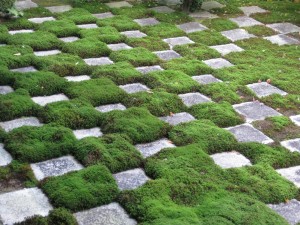Did you know that moss can be used to create a garden? Do you have a moist, shady area where it is difficult to garden or grow a lawn? Moss may be the perfect solution. Many have found moss gardens have a peaceful tranquility that is sublime. Some moss gardens incorporate rocks, paths, water features, and companion plants to draw birds, butterflies and desirable wildlife.

Photo by Jamie Butler
Moss gardening is eco-friendly, sustainable and can be low maintenance. It’s the perfect solution for the person who enjoys beauty and nature with little effort.
Today, moss gardens are receiving a re-birth. Their history dates back to Kyoto, Japan. The Japanese developed moss gardens, or Koke-dere, as quiet spaces for meditation. These were usually strolling gardens. The Zen Buddhist monks incorporated them in their temple gardens as peaceful areas for meditation.
Moss, in the right conditions, can cover large areas in a garden. It will grow in poor soil and prefers nutrient-deprived soils. One of its jobs is to clean the air; it absorbs nitrates and ammonia pollutants.
Moss thrives in a humid environment, and can survive periods of drought. The plant will turn brown, but after watering will return to its rich green color.
The most famous of these moss gardens can be found in Kyoto, Japan. It is on the grounds of a Temple known as Saiho-ji.
Moss is treated like an invasive weed in some gardens; however, the Japanese deliberately cultivated it as an aesthetic principle in their temple gardens. The monks cultivated large areas, creating a carpet-like effect. These gardens became places the monks enjoyed for meditation.

Photo by Majestic Wonders of the Northwest
Woodland gardens of moss cultivated to copy the Japanese aesthetic can be found in other areas in the world. The Bloedel Reserve in Washington State is a good example of Japanese temple gardens where moss is used as an aesthetic.
Moss is a type of plant that lacks the conventional root source. The name of the class is Bryophyta, meaning “the first green land plants.” The plants’ growth is more vertical and typically grows in moist shady areas. In America, moss is finding its way into gardens because it can sustain periods of drought. Some home-owners are using it as an alternative to growing lawns, and many enjoy cultivating it on flagstone walkways for its aesthetic as well as holding the stones in place.
To create and grow your own moss garden:
The acid in the soil:
Most of the information I have found indicates that moss gardens prefer an acid soil. The ph levels seem to vary from 4.5 to 6.5.
Location:
Most mosses prefer a shaded area and will grow in a densely shaded area with some light. Be sure to consider the sun’s location during the four seasons, as hot locations will burn the moss. Moss prefers a firm soil bed over a loose soil bed. Make sure your area is free from leaves and debris, since moss likes to be in direct contact with the soil.
I like to rake the area with a garden rake to free soil from anything that can block the moss from direct contact with the ground. I also notice that this gives the moss a better cohesiveness to the soil. Remember, moss prefers poor soil.
Planting:
If I am transplanting moss from one area of the property to another, I like using a square shovel that has been sharpened. This keeps the shovel from digging, and I can get under the root system and transplant the moss in sheets. I like to moisten (not saturate) the area where the new moss will go. This provides the moss a moist bed right away. I prefer using moss from the same property, as I find it takes more quickly. Press the moss into place with your hand or foot. Make sure the moss sheet has good contact on all sides and in the center. Water in, being careful not to saturate – mist spray is what I prefer. Water regularly for 3-6 weeks, and then water weekly or as needed.
Rocks:
If the desire is to grow moss on rocks, spread mud on the area of the rock to cover, use a small garden fork to create lines for better cohesion, then place moss on the rock and press into place. Water the moss in, being careful not to saturate. Water regularly and thoroughly for 3-6 weeks, and continue as needed, not letting the moss dry out or oversaturate.
Sources:
If there is no moss growing on your property, you can purchase moss from nurseries live, in boxes, or you can order it (or perhaps an obliging friend or neighbor will give you some).
If you want to propagate your own, crumble a large clump of moss about 8 to 12 inches into a blender with 2 cups buttermilk (I like to add 1/2 cup beer and 1/4 cup sugar to the mix), blend on lowest speed until milkshake consistency, and spread or paint on the ground, rocks, pots, statuary, or logs.
Moss food:
To keep your moss spreading, it needs food. Moss like a diet of buttermilk with beer and sugar added, misted with a hose daily (not saturated) for about 3-6 weeks, and then weekly or daily depending on how fast you want it to spread.



Comments on Chapelboro are moderated according to our Community Guidelines